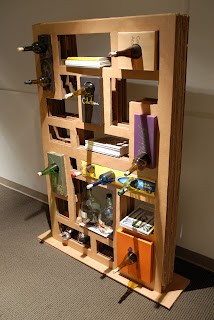From there, the idea to build an oprable shelf using cardboard and wine bottles was our final concept. We then created a small model to help us visualize. Furthermore, we gathered shoe boxes, shipping boxes from stores, and wine bottles of different sizes.
The small model
To began our shelf we contructed a layout of where the shelves would be and created a template so that every layer of cardboard would be the same. Several layers were carefully cut, placed, and glued together with a hot glue gun. Next, the cardboard shoe boxes were glued shut with the top and 2 inch radius circles were cut in the middle of them. This allowed for the wine bottles to be placed and glued through these holes in which the wine bottles could be used to hang scarfs or small sweaters. Afterwards, the shoeboxes were fitted and glued to the shelf. To keep the recycled effect of the appearance none of the materials were painted.
When the shelf was finished, it was tested to ensure it could hold objects such as magazines, shoes, and scarfs. The recycled shelf idea for the final was terrific and a great success in the class.

























